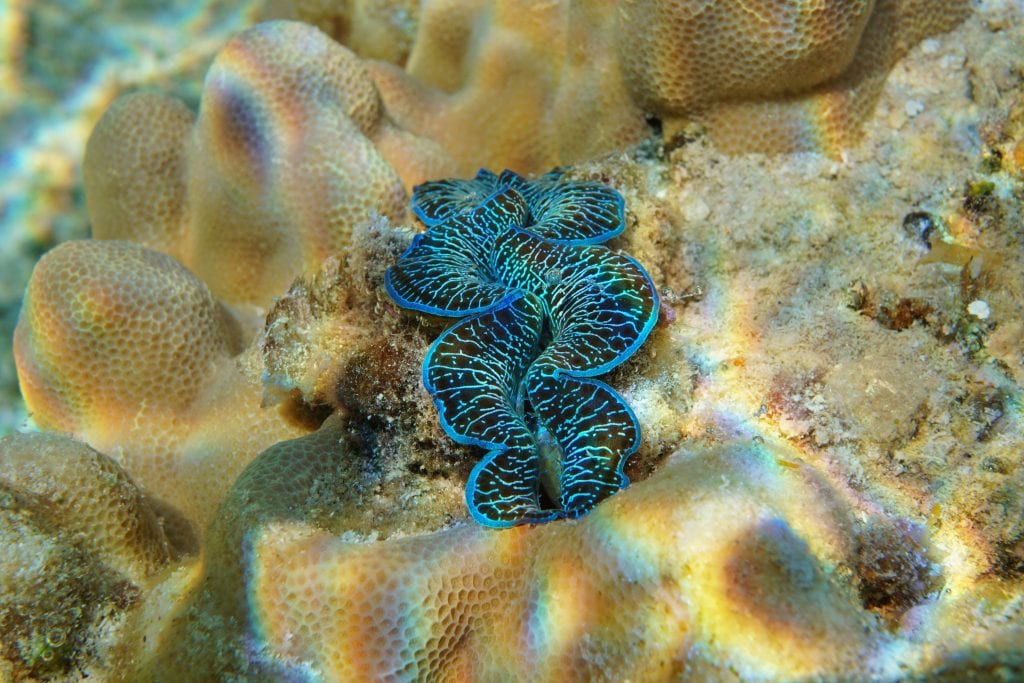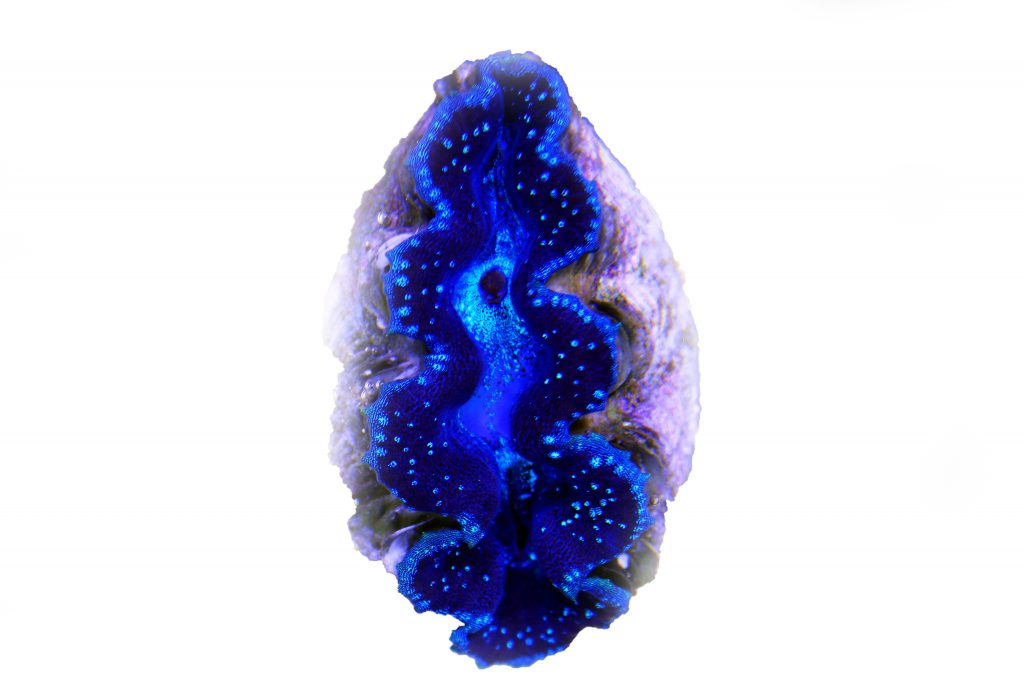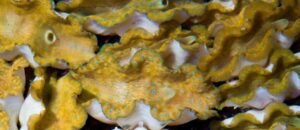 For a couple of decades now, tridacnid or “giant” clams (genera Tridacna and Hippopus) have been regarded as the cherries on top of any well-constructed and well-maintained reef aquarium. Though there have been a couple of newcomers along the way, most members of the relatively small family Tridacnidae have been available in the trade all the while (give and take some bumps along the road due to harvest/trade restrictions). Throughout this time, a single species has stood out as a clear favorite among reef aquarists: Tridacna maxima, the maxima clam.
For a couple of decades now, tridacnid or “giant” clams (genera Tridacna and Hippopus) have been regarded as the cherries on top of any well-constructed and well-maintained reef aquarium. Though there have been a couple of newcomers along the way, most members of the relatively small family Tridacnidae have been available in the trade all the while (give and take some bumps along the road due to harvest/trade restrictions). Throughout this time, a single species has stood out as a clear favorite among reef aquarists: Tridacna maxima, the maxima clam.
This is pretty understandable, considering this animal’s extraordinarily gorgeous mantle colors and patterns. Also, it is the smallest tridacnid at a normal adult size of less than 8 inches, allowing it to be kept in much smaller systems (it is sometimes referred to as the “small giant clam”).
Maxima clams have also earned a certain reputation for being one of the (if not THE) most challenging tridacnids to keep. And there are a few reasons for that! Of course, tridacnids are, as a whole, fairly delicate animals and undoubtedly demand both skilled and dedicated husbandry. But even among its high-maintenance brethren, T. maxima requires a little more effort. Specifically, this species:
- is most sensitive to poor water quality.
- needs the brightest light to support adequate zooxanthellate productivity.
- is more picky about its attachment substrate.
Long-term success with this attractive species requires that each of these issues is properly addressed. We shall begin with water quality requirements.
A clean scene
While all tridacnids are sensitive to suboptimal water quality, T. maxima is especially touchy. This makes them unsuited to a newly set up tank where some parameters could still be in flux. At a minimum, there should never be detectable concentrations of ammonia or nitrite. Even nitrate and phosphate should be maintained at nearly undetectable levels.
Alkalinity, pH, calcium and magnesium concentrations should remain on point for this shell-building creature. This means consistently very near to optimal conditions, not dipping to the lowest reaches of the typically “acceptable” aquarium conditions.
If the aquarium water isn’t generously replaced on a very regular basis (at least 25% weekly), it is wise to supplement trace elements. This ensures that both the clam and its symbiotic algae do not suffer from deficiencies of iodine, iron, etc.
Similarly, make sure that all other parameters are not just alright, but perfect. This means maintaining saturated oxygen levels, never letting the aquarium water get too warm or too cool, and so on! Stability is absolutely key with maxima clams.
On the bright side
T. maxima obtains most of its nourishment from its zooxanthellae–endosymbiotic, photosynthetic dinoflagellates. Because the clam is pretty much reliant on its symbiont for food, it needs quite a few of them. Yet, it has only so much space in its mantle to host them. It thus needs the zooxanthellae that is has to be as productive as possible. What that means is that it must expose them to as much sunlight as possible.
In the wild, T. maxima occurs only in clear, shallow waters that receive extremely bright sunshine. While the clam might close up completely at night, it spreads its mantle widely during daylight hours to catch as much sun as possible.
That’s in the tropics. If you guessed that it means you’ll need a bigger light for your aquarium, you guessed right. Put it this way: If it’s bright enough to grow acros, then it might be bright enough for a maxima clam. If it’s not sufficient for an acro, there’s no way it’ll keep a maxima alive for long. Don’t try to push your luck here, because lighting is one area where this species is definitely not forgiving.
Putting you clam close to the surface might help a bit, but in the end, if you don’t have the right (super intense) lighting, your clam is toast. Extending the photoperiod? That will practically do nothing to help.
One more time–REALLY bright light!
 A place to stay
A place to stay
T. maxima is fairly picky about where it “hangs out.” For one, as mentioned above, it is likely to settle into a spot that receives full sun exposure. Additionally, unlike a few of its close relatives, it will not be content to sit on a soft substrate. Rather, it loves to snuggle into a tight, rocky pocket. While placing them on the sand won’t necessarily harm them, they will likely waste energy to move somewhere else.
When a tridacnid settles into an area it likes, it anchors itself to the hard substrate with tough byssal threads. Pulling the clam away from an attached rock (or rock away from the clam) pulls at these attachments and can very seriously harm the animal. Also, an unattached clam can easily get knocked from its perch and tumble, presenting the threat of injury.
One way to avoid these hazards is to allow each specimen to attach itself firmly to a well-fitted rock (e.g. Clam Rocks); the rock can then be secured in a place (even high up on the hardscape) where it cannot fall.
Maximum satisfaction
For those willing to spend the time and money necessary to create an exceptionally healthy reef aquarium environment, a maxima clam (at least one!) is a great choice. It may be hard to believe that fully aquacultured specimens have been available in the trade for only about six years at the time of this writing. All farmed tridacnids, whether maricultured or bred entirely in aquaria, are considerably hardier than the wild ones that were once available. But even these farmed specimens are particular about water quality, lighting and substrate. Paying close attention to these three critical factors, one is well on their way to keeping and enjoying one of these magnificent mollusks for many years.






Amanda Zlab says
Thank you for more great info!
Michael Kirby says
Key is the maintaining any clam
Ellery Wong says
Trying to plan out some type of clam tank in a 50g Lowboy tank – Any suggestions on how to set one up with respect to having substrate or not? Also do they prefer more daylight spectrums instead of the more blue seen for Acros?
Ellery Wong says
Finally got at least 1 of each type but more is always welcome
s_coffman says
Great article, love the good information. I was new to saltwater reef keeping when I got my first Maxima clam. I had great luck with my clams. I did loose one but that was due to the ongoing battle with my snails. The snails were constantly pushing the clams over. Unfortunately they flipped one overand onto it’s mantle and killed it. But outside that they did great. I was using a hand built hood that matched the stand. I put 1 HQI metal halide with push pull fans and UV glass shield. The one that survived was a bark blue with electric blue metallic stripes.
Charles Folstrom says
Excellent information for anyone interested in getting a Clam
Kirby Hughes says
Want to add one of these to my large aquarium one day.
Kevin Gillenwater says
Informative article
Charles maresh says
This is one thing I really want when my new tank is 100% ready.
Charles maresh says
Really good information.
Victor says
A great read very informative this will help make for a happy home
Mr Papu says
Great article!
Mr Papu says
Great article! Very useful information.
Mr Papu says
Awesome post
Wolfthefallen says
Great information on how to keep a clam.
brotherbloat36 says
Very informative. Thank you for sharing!
Jennifer Kennedy says
Great info for potential owners!
Tanis Allan says
Great tips and advice!
dawn.g22 says
Great information!
Soren Shurtleff says
Great article! thanks
pweiss989 says
Very informative article on the beautiful yet challenging maxima clam!!
lemonpie755 says
Awesome!! Hope one day I can get one!!!
Scott Chase says
I used to love my Teardrop though they have been reclassified as a new species, I wish ORA would start to raise them as well
Matt says
The more stable you can make the water the better from what I’ve seen so far
SusanJAlvarezMD says
I love the teal color of these clams! Can’t wait to get one!
joshuastevens930 says
Very helpful information thank you
pumas0511 says
Awesome article. Thanks ? Algaebarn.
Douglas Ward says
Great article
John Collins says
Feeding time
David Cruz says
Great tips!
cc01lowrider says
Good lighting,stability and Fish are essential for clams. Have had them most of my life in this hobby and it seems they love a good tank with lots of fish.
straitmartin says
May be I’ll try Squamosa…
shrimppyshrimp says
Great information
Joe Willis says
Clams have always seemed out of reach for me but after reading I think my tank would support one.
rjulin22 says
My favorite type of clam, very informative. Just getting new lights maybe a new clam in my future
Dana Monteiro says
Just here so i dont get fined
Michael Wilson says
Fascinating and fact filled . Good knowledge for a great start .
Thanks.
Catherine says
Wonderful information!
Jeffrey Shifflett says
Very informative article.
kmwagner91 says
Happy as a clam
mattgulau says
Very informative!
Keaton Smith says
Great info
scott biron says
great information
nicole morrison says
Great info ?
Michael Horton says
Keeping a maxima now that seems to be doing well under T5s. I also used a clam holder – basically an oval ceramic unglazed ceramic piece with a divot in the middle. I think it really helped to keep the small clam upright until he secured himself. It’s not the most attractive thing, but I’m sure it eventually will get covered in coraline, and if I ever need to move the clam, I can move him with his holder.
John Rigg says
Great article!
John Rigg says
Great article!
John Rigg says
Great article, looking forward to learning more!
erin wirfel says
calc, alk and mag
Efrain Rodriguez says
Calcium alkalinity magnesium
Louisa JAmes says
Very pretty clam for sure. Don’t think I want one though.
Louisa JAmes says
Very pretty clam for sure. Don’t think I want one though.
Chell Slayton says
Thank you for another great article!
Anthony says
???
statru says
Educational and informative article!
mackey004 says
Ready for my maxima!
Allee Mackey says
Thanks for the info
Carlos Matias-Tejada says
this was a great article! very informative.
Patrick Pokrop says
Loving my Gold Maxima right now. This is great info!
shieldagent1 says
Great tips!
adubvu says
Very informative!!
shawn22vest says
Stable calcium, alk ph and par are key for clams
law says
I have all the correct paramaters for a clam.. can’t wait to order one!
joshirwin2 says
Stability is key!
alexstewartfish says
Amazing information, looking forward to getting one soon
camper66 says
Good info to know for newbies.
dcreeron says
Lots of good info!
Tim Brown says
I’d love to raise Maxima’s but they always seem so difficult.
rm.dyer says
Good read! Thank y’all
John Kellar says
Bookmarking this page for when I get a clam.
Natalie Fernandez says
Putting in extra effort to make this beautiful clam thrive in an aquarium is worth all the work. Seeing the ethereal colors and patterns of its mantle in a home aquarium just makes me feel all warm and happy. Definitely on my list to get one of these beauties.
chrismacdonald272 says
Great info
Bob Trimper says
a lot to think about
Lorri Blanton says
great info
John Rigg says
Interesting read!
heatherlv31 says
Good info
Jen FE DE LEON says
Now I’m considering setting up a tank just for clams! Thanks for the article.
Daniel Lenger says
my fav
laustinthought says
Great info!
Steve Miller says
Love it!
Douglas Jordan says
More light !
Michael Ehret says
I have everything the clam needs to thrive!
Michael Ehret says
I have everything the clam needs to thrive!
Amanda Rasberry says
Our hobby is keeping water, the livestock is the bonus for getting it right.
coleman.j85 says
Yes!
thillock says
Will be sure to set up my 120 to accommodate clams
thillock says
Now these or something I could really enjoy having in my tank
thillock says
Now these or something I could really enjoy having in my tank
Tejas Nair says
I cant wait for the day when clams become as popular as corals!
Erik Larsen says
Great tips!
Nick Seunath says
Great article
pastort.a.sherman says
Great information
Emily Anderson says
Always wanted to try keeping a maxima!
Travis Lund says
A quality light is a must in my experience
jumpin.jack says
Super excited to possibly get one soon
arthursu01@gmail.com says
Appreciate the tips!
alio1220000 says
So beautiful
Jahn Garcia says
Thanks
tony says
Much needed information for my maxima clam
Juan Perez says
Ready to care for one now.
reefbeard says
Gooallss!!!
obwhan says
Always more to learn
KRISTA FROST says
So pretty but way over my head yet.
KRISTA FROST says
So pretty but way over my head yet.
Troy says
Wish I had known these things when I got my first one….sigh
Philip says
Thank you for the great information.